Abstract
Ampicillin-sulbactam (750 mg) given orally twice daily for 10 days was evaluated for the treatment of acute pelvic inflammatory disease (PID) in an ambulatory setting in Nairobi, Kenya. The first 26 women received ampicillin-sulbactam in an open-label fashion, and the remaining 75 women were randomly selected to receive either ampicillin-sulbactam (n = 38) or cefoxitin (2 g) intramuscularly and probenecid (1 g) orally, followed by doxycycline (100 mg) orally twice daily for 10 days (n = 37). Women were enrolled in a sexually transmitted disease clinic and were followed for clinical and microbiologic responses at 1 to 2 weeks and 4 to 6 weeks posttreatment. Women had a later follow-up visit to note interim pregnancy or underwent hysterosalpingography for fertility outcome assessment. The short-term clinical response rates were 70% for ampicillin-sulbactam and 72% for cefoxitin-doxycycline (P = 0.47). Among Chlamydia trachomatis-infected women treated with ampicillin-sulbactam, three had microbiologic relapse. The post-PID tubal obstruction rates were similar in the two groups: 18% for ampicillin-sulbactam and 33% for cefoxitin-doxycycline (P = 0.31). Neither regimen was highly effective as a therapy for acute PID. These data strongly argue that primary prevention must be the goal for a reduction of PID morbidity and show that improved therapy for the treatment of PID in the ambulatory setting is needed.
Full text
PDF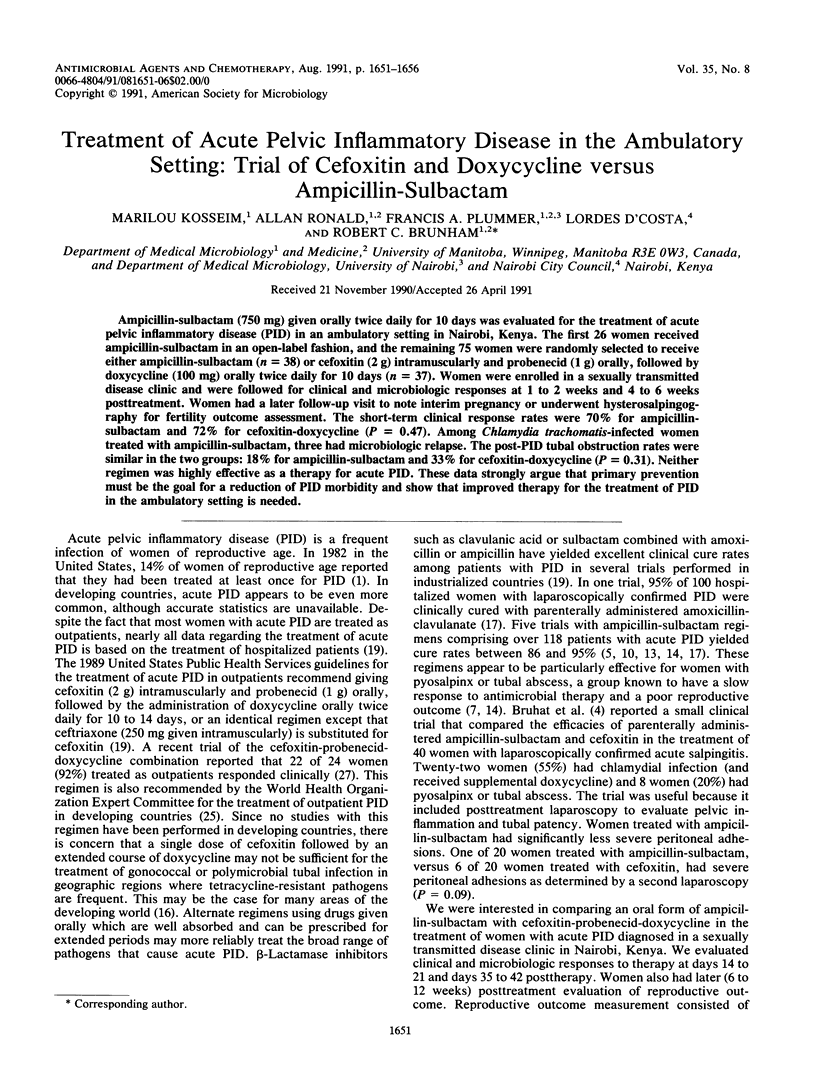
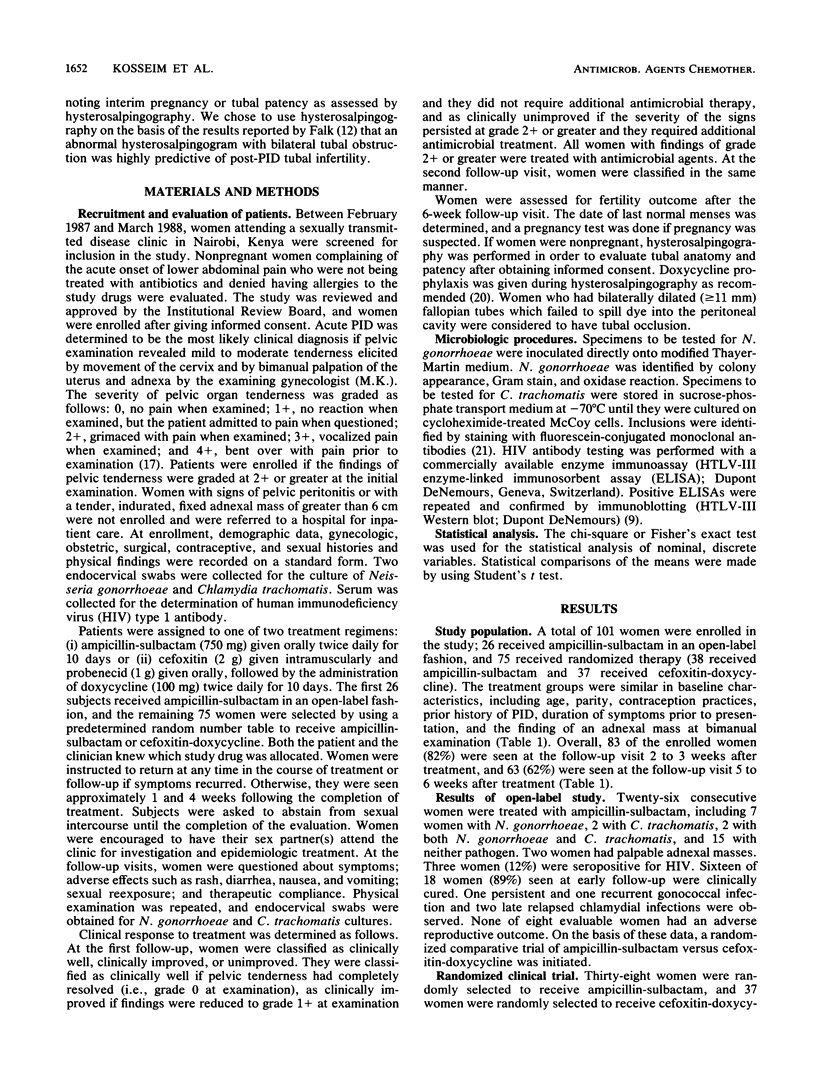
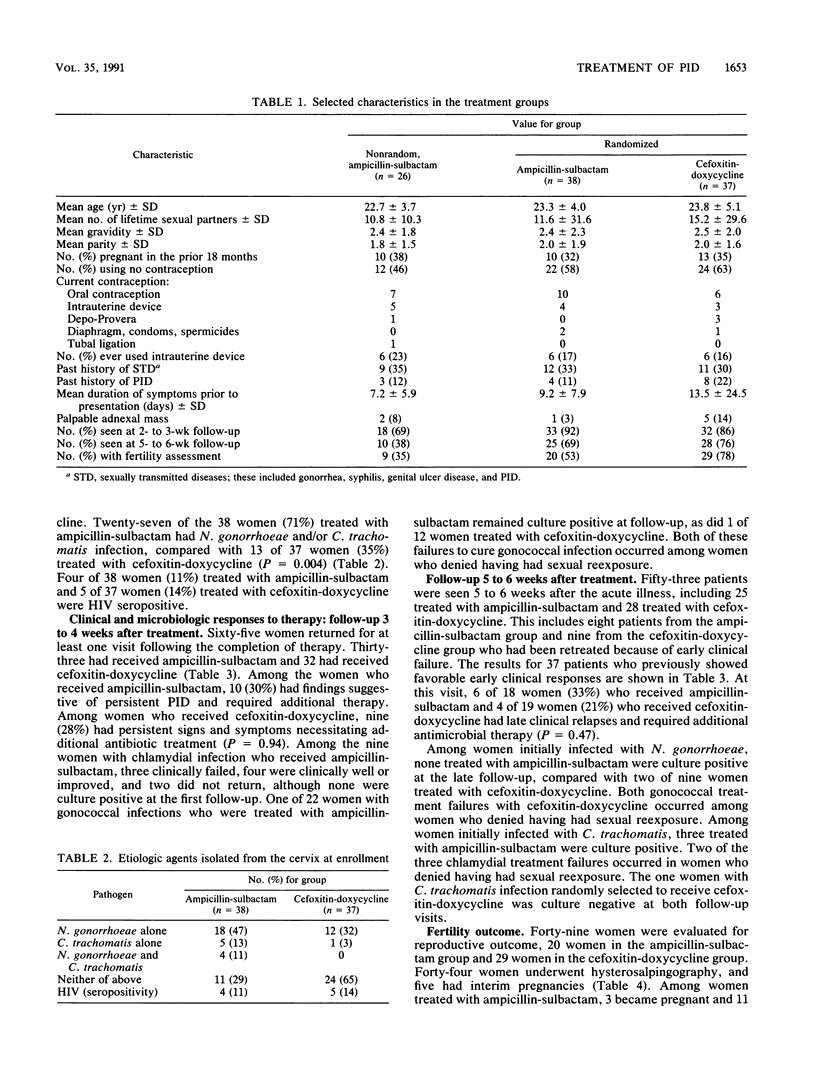
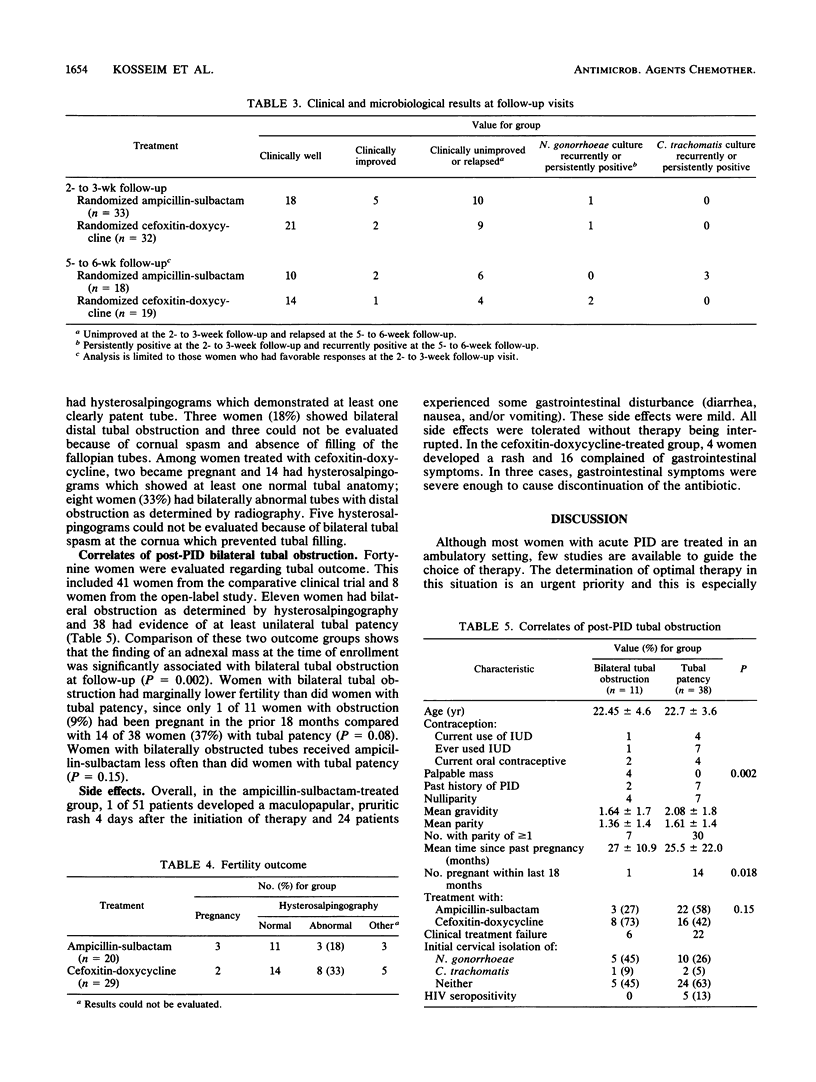
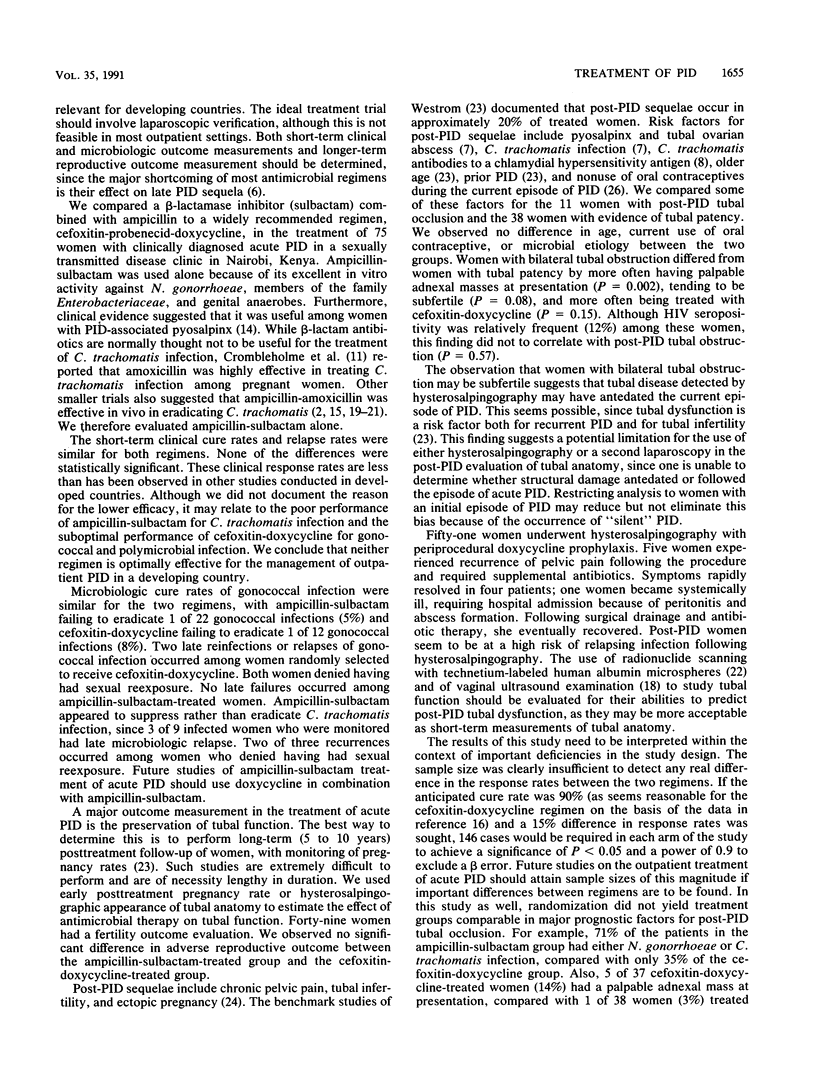
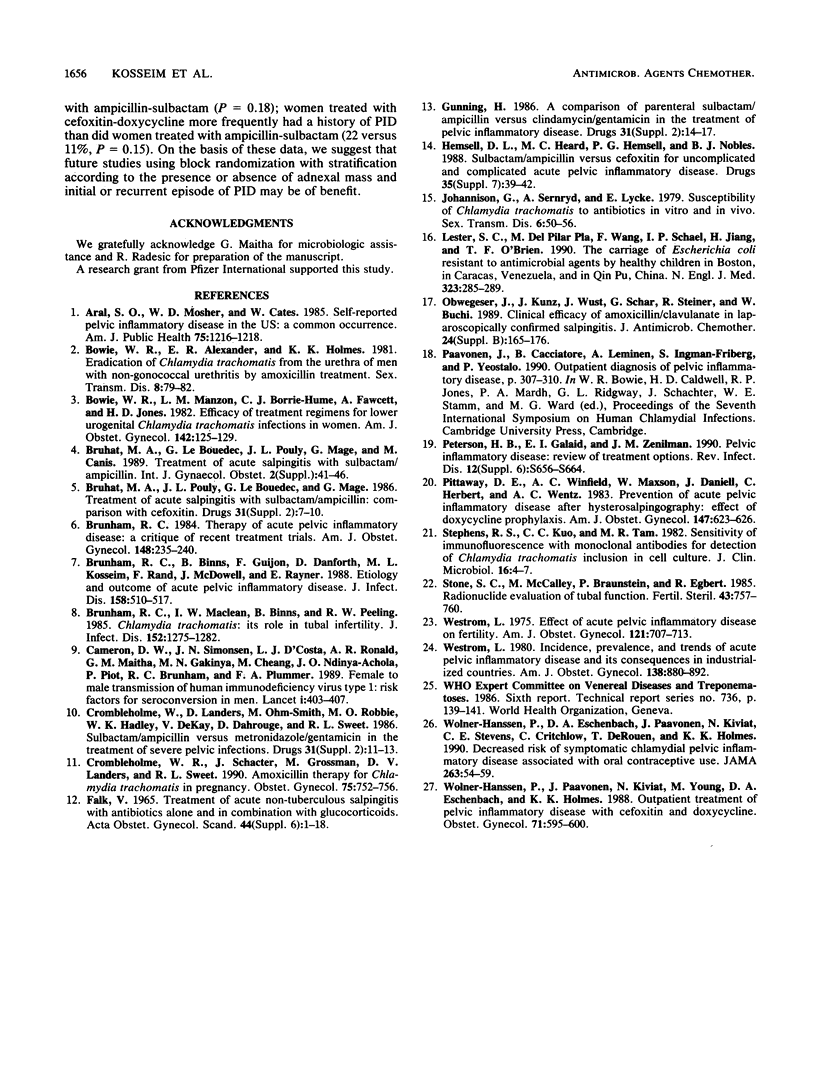
Selected References
These references are in PubMed. This may not be the complete list of references from this article.
- Aral S. O., Mosher W. D., Cates W., Jr Self-reported pelvic inflammatory disease in the US: a common occurrence. Am J Public Health. 1985 Oct;75(10):1216–1218. doi: 10.2105/ajph.75.10.1216. [DOI] [PMC free article] [PubMed] [Google Scholar]
- Bowie W. R., Alexander E. R., Holmes K. K. Eradication of Chlamydia trachomatis from the urethras of men with nongonococcal urethritis by treatment with amoxicillin. Sex Transm Dis. 1981 Apr-Jun;8(2):79–81. doi: 10.1097/00007435-198104000-00010. [DOI] [PubMed] [Google Scholar]
- Bowie W. R., Manzon L. M., Borrie-Hume C. J., Fawcett A., Jones H. D. Efficacy of treatment regimens for lower urogenital Chlamydia trachomatis infection in women. Am J Obstet Gynecol. 1982 Jan 15;142(2):125–129. doi: 10.1016/s0002-9378(16)32325-0. [DOI] [PubMed] [Google Scholar]
- Bruhat M. A., Pouly J. L., Le Boedec G., Mage G. Treatment of acute salpingitis with sulbactam/ampicillin. Comparison with cefoxitin. Drugs. 1986;31 (Suppl 2):7–10. doi: 10.2165/00003495-198600312-00002. [DOI] [PubMed] [Google Scholar]
- Brunham R. C., Binns B., Guijon F., Danforth D., Kosseim M. L., Rand F., McDowell J., Rayner E. Etiology and outcome of acute pelvic inflammatory disease. J Infect Dis. 1988 Sep;158(3):510–517. doi: 10.1093/infdis/158.3.510. [DOI] [PubMed] [Google Scholar]
- Brunham R. C., Maclean I. W., Binns B., Peeling R. W. Chlamydia trachomatis: its role in tubal infertility. J Infect Dis. 1985 Dec;152(6):1275–1282. doi: 10.1093/infdis/152.6.1275. [DOI] [PubMed] [Google Scholar]
- Brunham R. C. Therapy for acute pelvic inflammatory disease: a critique of recent treatment trials. Am J Obstet Gynecol. 1984 Feb 1;148(3):235–240. doi: 10.1016/s0002-9378(84)80061-7. [DOI] [PubMed] [Google Scholar]
- Cameron D. W., Simonsen J. N., D'Costa L. J., Ronald A. R., Maitha G. M., Gakinya M. N., Cheang M., Ndinya-Achola J. O., Piot P., Brunham R. C. Female to male transmission of human immunodeficiency virus type 1: risk factors for seroconversion in men. Lancet. 1989 Aug 19;2(8660):403–407. doi: 10.1016/s0140-6736(89)90589-8. [DOI] [PubMed] [Google Scholar]
- Crombleholme W. R., Schachter J., Grossman M., Landers D. V., Sweet R. L. Amoxicillin therapy for Chlamydia trachomatis in pregnancy. Obstet Gynecol. 1990 May;75(5):752–756. [PubMed] [Google Scholar]
- Crombleholme W., Landers D., Ohm-Smith M., Robbie M. O., Hadley W. K., DeKay V., Dahrouge D., Sweet R. L. Sulbactam/ampicillin versus metronidazole/gentamicin in the treatment of severe pelvic infections. Drugs. 1986;31 (Suppl 2):11–13. doi: 10.2165/00003495-198600312-00003. [DOI] [PubMed] [Google Scholar]
- Gunning J. A comparison of parenteral sulbactam/ampicillin versus clindamycin/gentamicin in the treatment of pelvic inflammatory disease. Drugs. 1986;31 (Suppl 2):14–17. doi: 10.2165/00003495-198600312-00004. [DOI] [PubMed] [Google Scholar]
- Hemsell D. L., Heard M. C., Hemsell P. G., Nobles B. J. Sulbactam/ampicillin versus cefoxitin for uncomplicated and complicated acute pelvic inflammatory disease. Drugs. 1988;35 (Suppl 7):39–42. doi: 10.2165/00003495-198800357-00010. [DOI] [PubMed] [Google Scholar]
- Johannisson G., Sernryd A., Lycke E. Susceptibility of Chlamydia trachomatis to antibiotics in vitro and in vivo. Sex Transm Dis. 1979 Apr-Jun;6(2):50–57. doi: 10.1097/00007435-197904000-00002. [DOI] [PubMed] [Google Scholar]
- Lester S. C., del Pilar Pla M., Wang F., Perez Schael I., Jiang H., O'Brien T. F. The carriage of Escherichia coli resistant to antimicrobial agents by healthy children in Boston, in Caracas, Venezuela, and in Qin Pu, China. N Engl J Med. 1990 Aug 2;323(5):285–289. doi: 10.1056/NEJM199008023230501. [DOI] [PubMed] [Google Scholar]
- Obwegeser J., Kunz J., Wüst J., Schär G., Steiner R., Büchi W. Clinical efficacy of amoxycillin/clavulanate in laparoscopically confirmed salpingitis. J Antimicrob Chemother. 1989 Nov;24 (Suppl B):165–176. doi: 10.1093/jac/24.suppl_b.165. [DOI] [PubMed] [Google Scholar]
- Peterson H. B., Galaid E. I., Zenilman J. M. Pelvic inflammatory disease: review of treatment options. Rev Infect Dis. 1990 Jul-Aug;12 (Suppl 6):S656–S664. doi: 10.1093/clinids/12.supplement_6.s656. [DOI] [PubMed] [Google Scholar]
- Pittaway D. E., Winfield A. C., Maxson W., Daniell J., Herbert C., Wentz A. C. Prevention of acute pelvic inflammatory disease after hysterosalpingography: efficacy of doxycycline prophylaxis. Am J Obstet Gynecol. 1983 Nov 15;147(6):623–626. doi: 10.1016/0002-9378(83)90438-6. [DOI] [PubMed] [Google Scholar]
- Stephens R. S., Kuo C. C., Tam M. R. Sensitivity of immunofluorescence with monoclonal antibodies for detection of Chlamydia trachomatis inclusions in cell culture. J Clin Microbiol. 1982 Jul;16(1):4–7. doi: 10.1128/jcm.16.1.4-7.1982. [DOI] [PMC free article] [PubMed] [Google Scholar]
- Stone S. C., McCalley M., Braunstein P., Egbert R. Radionuclide evaluation of tubal function. Fertil Steril. 1985 May;43(5):757–760. doi: 10.1016/s0015-0282(16)48561-4. [DOI] [PubMed] [Google Scholar]
- Weström L. Effect of acute pelvic inflammatory disease on fertility. Am J Obstet Gynecol. 1975 Mar 1;121(5):707–713. doi: 10.1016/0002-9378(75)90477-9. [DOI] [PubMed] [Google Scholar]
- Weström L. Incidence, prevalence, and trends of acute pelvic inflammatory disease and its consequences in industrialized countries. Am J Obstet Gynecol. 1980 Dec 1;138(7 Pt 2):880–892. doi: 10.1016/0002-9378(80)91077-7. [DOI] [PubMed] [Google Scholar]
- Wølner-Hanssen P., Eschenbach D. A., Paavonen J., Kiviat N., Stevens C. E., Critchlow C., DeRouen T., Holmes K. K. Decreased risk of symptomatic chlamydial pelvic inflammatory disease associated with oral contraceptive use. JAMA. 1990 Jan 5;263(1):54–59. doi: 10.1001/jama.1990.03440010052029. [DOI] [PubMed] [Google Scholar]
- Wølner-Hanssen P., Paavonen J., Kiviat N., Young M., Eschenbach D. A., Holmes K. K. Outpatient treatment of pelvic inflammatory disease with cefoxitin and doxycycline. Obstet Gynecol. 1988 Apr;71(4):595–600. [PubMed] [Google Scholar]


